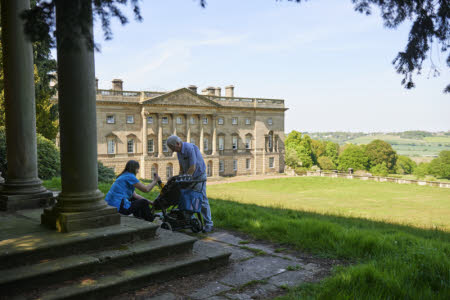
The National Trust, a conservation charity that operates many of the UK’s most-visited natural and historic attractions, has been hit hard by lockdowns. But as CIO Jon Townsend tells Tech Monitor, providing access to nature has never been more important, and technology investments including a network refresh and a customer data transformation have allowed the Trust to deliver its mission despite the pandemic.
Fibre to the stately home
The Trust knows the meaning of the phrase ‘legacy estate’ better than most organisations. Currently celebrating its 125th year, it manages 780 miles of coastline, over 250,000ha of land, and 1m pieces of art housed in over 500 historic buildings.

And until recently, ‘historic’ was an apt description of much of its network infrastructure. “We were trying to run an organisation with upwards of 350 major visitor sites, and another 150 outdoor spaces, with a network that was built on old copper that was rotting in the ground,” explains Townsend.
“Some of our sites had about a half-megabit link. You couldn’t run a mobile phone on that nowadays,” he adds. “And we used to have a major network outage almost every day.”
In 2019, the charity completed an extensive networking refresh. “We undertook a major piece of work with [UK wholesale network operator] Openreach to put fibre optics into the majority of our properties. We finished that last year and now all of our major sites run full fibre to the property.”
“With Cisco, we worked through replacing all of our network devices and modernising all of that network infrastructure,” he adds. “So all of our routers and switches, all wireless access points right across the organisation [were replaced] to really bring us into this century from a networking perspective.”
This has unlocked new possibilities, including a pilot scheme to catalogue the artefacts located in the Trust’s properties using RFID tags. “Some of our buildings have hundreds of thousands of items,” explains Townsend. “Cataloguing those items becomes a lot easier with RFID technology. You can go straight to the item because you’ve got a clear understanding of where it is.”
Transforming the supporter experience
Before lockdown, the Trust had also upgraded its workplace technology offering to allow employees to work remotely.
“With a great deal of fortune and a lot of expert planning, we were moving into a transformation of our workplace,” says Townsend. “That was all about enabling people to work from wherever they needed to be, which was lucky as, when Covid-19 hit, we were very well placed.”
However, one aspect of the Trust’s digital transformation that was not complete in time for the pandemic would prove to be one of the most critical.
It had previously identified that its systems for managing online interactions with its 5.6 million members and other supporters were not fit for purpose. It therefore embarked on building a new system to manage member and supporter engagement. After a year-long scoping and tendering process, the Trust selected technology from cloud software provider Salesforce and implementation services from IT consultancy Atos.
That project kicked off in January. “We were doing a major Salesforce implementation for our membership and our fundraising services, which also included a complete overhaul of our integration platform,” says Townsend. This overhaul included moving away from a system of siloed data warehouses towards a master data management (MDM) regime.
A nationwide lockdown in spring gave new urgency to the project, as online interaction became the only kind possible. Luckily, the National Trust and its partners were able to complete the project despite the disruption.
The resulting improvements to data access and quality have helped supporters and members tap into more services across the organisation, and given the Trust a deeper understanding of its community, says Townsend.
“Giving people genuine choice about what the National Trust could offer to them, and having that greater understanding of who our supporters are and what they wanted from us, enabled our supporters to stay in touch with the organisation, but more importantly, also to stay in touch with nature.”
As such, this customer-facing dimension of the charity’s digital transformation has helped it fulfil its core purpose in the face of severe budgetary constraints.
“The impact [of Covid-19] financially was huge on the trust,” explains Townsend. “Around £200m in lost revenue, which, for a charity, is really hard, and has impacted on our ability to do a lot of projects that we want to do this year.”
“We are absolutely determined to continue to provide that public benefit to allow people to get outdoors and enjoy nature. Because I think people need that more than ever now.”






